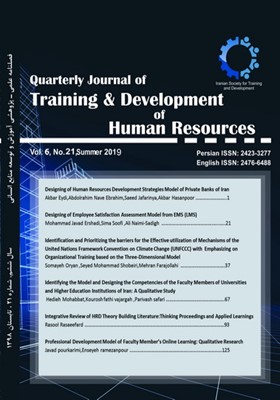-
-
List of Articles
-
Open Access Article
1 - Identifying the Model and Designing the Competencies of the Faculty Members of Universities and Higher Education Institutions of Iran: A Qualitative Study
Hedieh Mohabbat Kurosh Fathi Vajargah Parivash Jaafari -
Open Access Article
2 - Professional development model of faculty member’s online learning: qualitative research
javad Poorkarimi Ensieh Ramezanpour -
Open Access Article
3 - Presentation of Employee Satisfaction Assessment Model from EMS (LMS)
Sima Soofi Mohammad Javad Ershadi Ali Naimi Sadigh -
Open Access Article
4 - Integrative Review of HRD Theory Building Literature: Thinking Proceedings and Applied Learnings
Rasool Rasayi Fard -
Open Access Article
5 - Designing of Human Resources Development Strategies Model of Private Banks of Iran
Akbar Eydi abdolrahim navehebrehim Saeed Jaafari Nia Akbar Hasanpour -
Open Access Article
6 - Identification and Prioritizing the barriers to effective utilization of Mechanisms of United Nations Framework Convention on Climate Change (UNFCCC) by Emphasizing on organizational training based on the Three-Dimensional Model
Somayeh Oryan Seyed Mohammad Shobeiri Mehran Farajollahi
-
The rights to this website are owned by the Raimag Press Management System.
Copyright © 2017-2026







